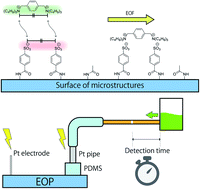Simple chemical detection based on a surface-modified electroosmotic pump via interval immobilization
Abstract
Environmental water quality monitoring plays an important role in human health risk assessments for pharmaceuticals in water and pollutant source control. A new chemical detection method was developed to enhance molecular selectivity and portability by combining the molecularly imprinted technique and an electroosmotic pump (EOP), which requires only a small pump, batteries and stopwatch in principle. Selective chemical adsorption on the surface-modified EOP decreases the pumping performance of EOP due to a decrease in the surface electric charge. For proof of concept, the microfabricated EOPs with chemical surface treatment were used to investigate the effects of surface chemical change on pumping performance. The microfluidic EOP of a size of 20 mm × 20 mm × 1 mm was modified by an interval immobilization method using the template of 4-(tributylammonium-methyl)-benzyltributylammonium chloride (TBTA) and evaluated by measuring EOF. The pumping performance of the surface-modified EOP was decreased by the selective adsorption of TBTA to a two-point recognition site on the EOP surfaces. The relationships between the flow rate and the TBTA concentration were fitted to the Langmuir equation. The EOP can selectively detect the model substance even in a mixture solution with a different chemical compound. This molecular imprinted EOP does not require large and expensive instruments for driving the device and chemical detection, which can be applied to a portable analytical device for onsite analysis.

- This article is part of the themed collection: Analytical Methods HOT Articles 2021


 Please wait while we load your content...
Please wait while we load your content...